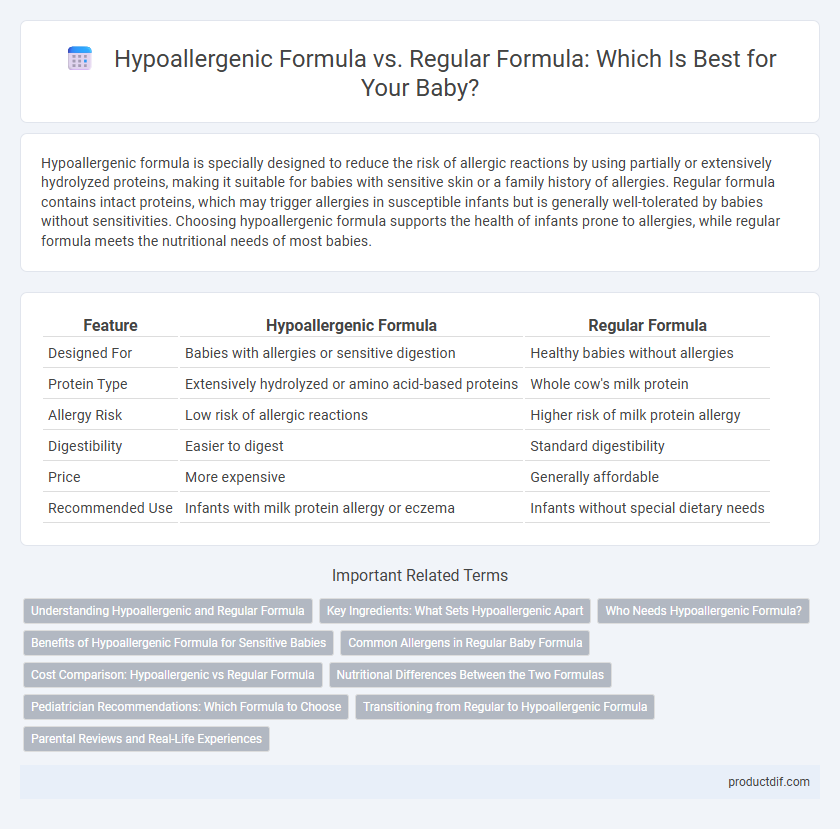Hypoallergenic formula is specially designed to reduce the risk of allergic reactions by using partially or extensively hydrolyzed proteins, making it suitable for babies with sensitive skin or a family history of allergies. Regular formula contains intact proteins, which may trigger allergies in susceptible infants but is generally well-tolerated by babies without sensitivities. Choosing hypoallergenic formula supports the health of infants prone to allergies, while regular formula meets the nutritional needs of most babies.
Table of Comparison
| Feature | Hypoallergenic Formula | Regular Formula |
|---|---|---|
| Designed For | Babies with allergies or sensitive digestion | Healthy babies without allergies |
| Protein Type | Extensively hydrolyzed or amino acid-based proteins | Whole cow's milk protein |
| Allergy Risk | Low risk of allergic reactions | Higher risk of milk protein allergy |
| Digestibility | Easier to digest | Standard digestibility |
| Price | More expensive | Generally affordable |
| Recommended Use | Infants with milk protein allergy or eczema | Infants without special dietary needs |
Understanding Hypoallergenic and Regular Formula
Hypoallergenic formula is designed to reduce the risk of allergic reactions by breaking down proteins into smaller peptides, making it easier for sensitive babies to digest. Regular formula contains whole proteins that can sometimes trigger allergies or digestive discomfort in infants prone to sensitivities. Choosing between hypoallergenic and regular formula depends on a baby's specific health needs, family history of allergies, and pediatrician recommendations.
Key Ingredients: What Sets Hypoallergenic Apart
Hypoallergenic baby formula contains extensively hydrolyzed proteins or amino acids that reduce the risk of allergic reactions, unlike regular formula which typically uses intact cow's milk proteins. Key ingredients such as partially or extensively hydrolyzed whey and casein help break down proteins into smaller peptides, making them easier for sensitive infants to digest. Specialized fats and added prebiotics in hypoallergenic formulas also support gut health and immune function, differentiating them from standard formulas.
Who Needs Hypoallergenic Formula?
Hypoallergenic formula is specifically designed for infants with cow's milk protein allergy or severe eczema, providing proteins broken down into smaller, less allergenic peptides to minimize allergic reactions. Regular formula contains intact proteins suitable for most healthy babies without known allergies or intolerances. Pediatricians recommend hypoallergenic formula for babies exhibiting signs of milk protein allergy, such as vomiting, diarrhea, or skin rashes, ensuring safe and comfortable feeding.
Benefits of Hypoallergenic Formula for Sensitive Babies
Hypoallergenic formula offers specialized nutrition designed to reduce the risk of allergic reactions in sensitive babies by using pre-digested proteins that are easier to absorb. This formula supports digestive comfort and helps alleviate common symptoms like colic, gas, and skin irritations often caused by regular formula. Choosing hypoallergenic options promotes better overall health and development for infants prone to allergies or intolerances.
Common Allergens in Regular Baby Formula
Regular baby formula often contains common allergens such as cow's milk protein, soy, and lactose, which can trigger allergic reactions in sensitive infants. Hypoallergenic formulas are specially designed to break down these proteins into smaller peptides, reducing the risk of allergies and digestive discomfort. Parents seeking to prevent allergic reactions typically choose hypoallergenic options to safeguard babies prone to milk protein intolerance or soy allergies.
Cost Comparison: Hypoallergenic vs Regular Formula
Hypoallergenic formula typically costs two to three times more than regular formula due to specialized ingredients and extensive processing to reduce allergens. Families opting for hypoallergenic formula should consider the higher price per ounce, which can significantly impact monthly expenses. Budgeting for hypoallergenic formula requires evaluating the balance between allergy management benefits and the financial investment compared to standard formula prices.
Nutritional Differences Between the Two Formulas
Hypoallergenic formula contains extensively hydrolyzed or amino acid-based proteins designed to minimize allergic reactions, while regular formula typically uses intact cow's milk proteins. Nutritionally, hypoallergenic formulas often have modified protein structures for easier digestion but maintain essential vitamins, minerals, and fatty acids comparable to regular formulas. Infants with allergies or sensitivities benefit from hypoallergenic options without compromising key nutritional requirements for growth and development.
Pediatrician Recommendations: Which Formula to Choose
Pediatricians often recommend hypoallergenic formula for infants with a high risk of allergies or those showing signs of intolerance to regular formula, as it contains proteins that are extensively hydrolyzed or partially broken down to reduce allergenic potential. Regular formula is generally advised for healthy infants without family history of allergies, providing complete nutrition with intact cow's milk proteins. Choosing the right formula depends on a pediatrician's assessment of the baby's health, feeding tolerance, and allergy risk factors.
Transitioning from Regular to Hypoallergenic Formula
Transitioning from regular to hypoallergenic baby formula requires carefully monitoring for allergic reactions and digestive comfort, as hypoallergenic formulas are designed to reduce proteins that commonly cause allergies. Pediatricians recommend gradually introducing hypoallergenic formula to help the baby adjust and to identify potential food sensitivities. Choosing clinically tested hypoallergenic formulations, such as extensively hydrolyzed or amino acid-based products, supports infants with cow's milk protein intolerance or eczema, ensuring optimal nutrition during the changeover period.
Parental Reviews and Real-Life Experiences
Parents report that hypoallergenic formula often reduces allergic reactions like colic and eczema compared to regular formula, improving infant comfort and sleep quality. Many real-life experiences highlight hypoallergenic options as essential for babies with sensitive digestion or family history of allergies. Regular formula tends to be favored for ease of availability and lower cost, but parental feedback underscores the health benefits of hypoallergenic varieties in managing dietary sensitivities.
Hypoallergenic formula vs regular formula Infographic

 productdif.com
productdif.com